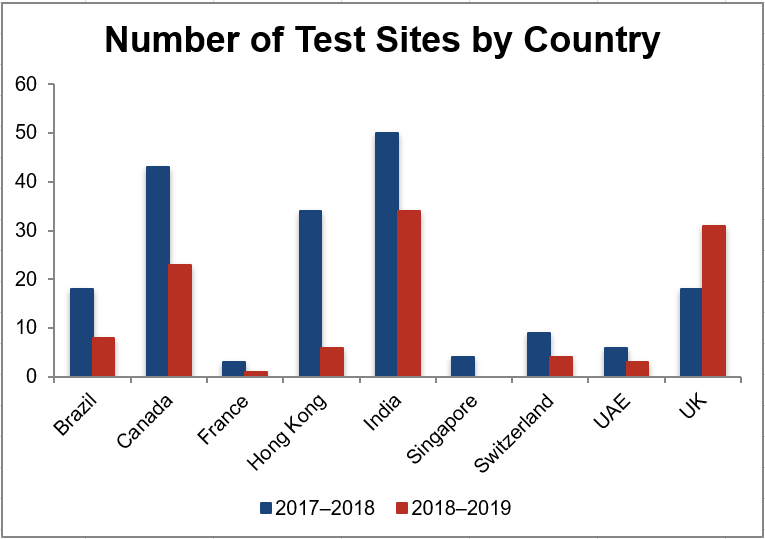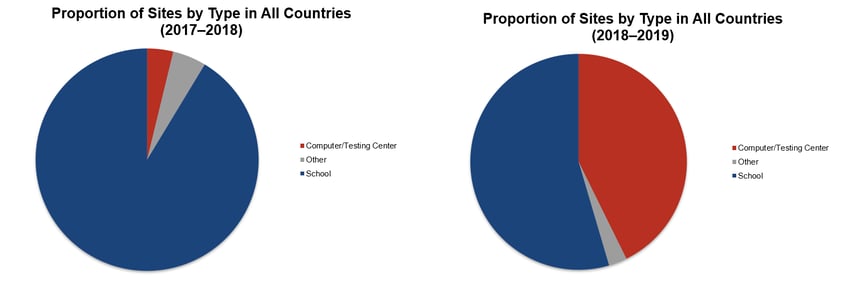UPDATE [August 10, 2018]: Since this article was originally posted, ACT has updated its list of available test centers. Click here for the current list.
Registration is open for the first year of the computer-based ACT!
Throughout ACT’s transition to a computer-based test for non-U.S. test takers, one of the biggest questions has been “Will there be enough test sites?” We examined the available data to find the important takeaways. Below we’ve highlighted the key trends and the implications for each.
Study Outline
Before we start, a quick overview of the analysis we did. We selected nine countries where large numbers of students traditionally take the ACT:
Brazil
Canada
France
Hong Kong
India
Singapore
Switzerland
United Arab Emirates
United Kingdom
For last year’s data (2017-2018 school year), we collated a list of all sites that offered the exam along with the dates each site offered the exam. We used a list from ACT’s website, which was active up until July 19 but has now been taken down. For the data on the new computer-based test (CBT), we used the list ACT has published as well as sites listed this week in ACT’s registration portal for this coming school year (2018–2019).
A few things to keep in mind about the trends and analysis below: First, we are only able to collect data on the number of sites available, not the number of seats. While the number of sites may rise, the number of seats available to student may rise, fall, or stay the same. ACT has not published the number of seats available. Second, the site list could still be in flux for 2018–2019. ACT can—and is likely—to add or change the list as the year progresses and more sites come on board.
Trends
NUMBER OF SITES: In our sample, the total the number of sites is down 41% (from 185 to 110). Out of the 9 countries we studied, only the UK gained sites (from 18 to 31). Singapore was hit the hardest (from 4 to 0 sites), followed by Hong Kong, which dropped 85% (from 34 to 5 sites). France dropped from 4 sites just to 1, and that 1 site is currently designated as “not yet active” in ACT’s registration portal.

TAKEAWAY: While one country won the lottery here, most countries have seen a decrease in the number of sites. This change could mean additional travel for students, a factor that hit the Asian countries in our sample the hardest.
SHIFTING SITES: Another interesting trend has been the number of sites that hosted in the past but chose not to do so this year. In our sample, 75% of all sites that hosted the ACT last year have stopped offering it. Nearly 60% of all test sites this year are new test sites.
TAKEAWAY: While students may still have access to a site in their area, it’s likely to be a site where they haven’t taken the test before. For many, this change won’t have a big impact.
TYPES OF SITES: As expected, testing is heavily shifting towards sites whose core business is test administration and computer testing. The number of computer/testing centers offering the ACT is up 571% (from 7 to 47). Schools were hit the hardest. Although 165 schools hosted the exam last year, only 59 will this year. By looking at the data in another way, we can see the impact of this shift even more: in 2017–2018 school year 91% of test sites were schools and only 4% were computer/testing centers. In 2018–2019 only 54% of sites will be schools while 43% will be computer/testing centers. The shift has been most significant in India and the UK.

TAKEAWAY: As we predicted, many schools either weren’t able or weren’t willing to commit to the demands of the new CBT exam. But the ACT has made a strong effort to replace those lost schools with other types of sites, especially computer centers. This change may actually benefit students as noted below. It also may ensure a more consistent testing experience when the exam is proctored by a site that handles computer tests on a regular basis.
CBT WITH 50% EXTENDED TIME ACCOMMODATION: In the past, all international students with accommodations qualified for Special Testing: they took the ACT at their home schools on a school day. This year, if a student takes the test with 50% extended time on a single day, she can take the CBT at a test center with standard students. When we looked at this year’s test sites online through the registration portal, we found that very few offer the accommodated test. In fact, only 9 of the 110 sites offering the ACT this year also offer the test with accommodations (2 in Brazil, 3 in Canada, 1 in Switzerland, 1 in the UAE, and 2 in the UK; sites in France, Hong Kong, and India do not offer it).
TAKEAWAY: The severely restricted number of CBT sites offering testing accommodations may limit the number of students who will take the CBT test with accommodations. In ACT’s defense, we are hearing reports from students that they have called ACT and received additional help. Some have been able to register for accommodated testing at CBT centers that appear online not to offer the accommodated test, but students have only been able to do so when registering by phone. ACT has also indicated to us that 50%-extended-time students can register for the paper-based test instead. However, this process is still a bit murky. We advise students with 50% extended time to call ACT directly to learn all the options.
TEST DATES OFFERED: When we dug deeper to see the number of sites offering the test each test date (by date we refer here to the months the ACT is given: September, October, December, February, April, and June), there are other trends to note:
- When we count the number of “testing opportunities,” which we calculated by adding the test sites available each month, there will be more “testing opportunities” this school year. In 2017–2018 there were only 467 testing opportunities, but there will be 529 in 2018–2019 (a 13% increase). All of these gains, however, were limited to India and the UK. All other countries in our sample lost “testing opportunities.”
- There were clear winning and losing months. September gained a large number of sites (from 58 to 90), as did February (from 12 to 89). September’s jump is largely due to the fact that India had no test sites in September 2017 but will have 33 this year. February’s jump is entirely explained by the addition of February as a test date for international students for the first time. (Note the 12 sites from last year were all in Canada, which tested under the U.S. system in 2017–2018 but will be on the international system in 2018–2019.) All other months saw an 8% to 15% decrease in number of available sites.
- In each country this year, there will be fewer fluctuations month-to-month in the number of sites offering the test. This in large part is due to the move towards testing/computer centers for which tests like the ACT are the primary focus. This is one of the benefits of moving to such sites. Many of these sites can commit to most—if not all—test dates.
TAKEAWAY: UK and Indian students gained a large number of “testing opportunities.” But other students lost out and will need to watch sites and available dates carefully to plan their testing schedules. The addition of February has been a boon for many students across multiple countries and will likely become a popular test date. Furthermore, the more consistent schedule of dates offered year-round at new test sites may make it easier for students to plan their testing schedules.






